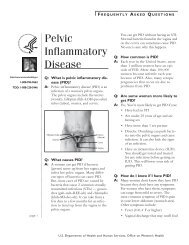Human Papillomavirus (HPV) and Genital Warts - WomensHealth.gov
Human Papillomavirus (HPV) and Genital Warts - WomensHealth.gov
Human Papillomavirus (HPV) and Genital Warts - WomensHealth.gov
Create successful ePaper yourself
Turn your PDF publications into a flip-book with our unique Google optimized e-Paper software.
F r e q u e n t l y As k e d Qu e s t i o n s<br />
http://www.womenshealth.<strong>gov</strong><br />
1-800-994-9662<br />
TDD: 1-888-220-5446<br />
able to stop having Pap tests. Discuss<br />
your needs with your doctor.<br />
• If you had your cervix taken out as<br />
part of a hysterectomy, you do not<br />
need further Pap tests if the surgery<br />
was not due to cancer.<br />
• Talk with your doctor or nurse<br />
about when to begin testing, how<br />
often you should be tested, <strong>and</strong><br />
when you can stop.<br />
Q: What happens if I have an<br />
abnormal Pap test?<br />
A: An abnormal result does not mean you<br />
have <strong>HPV</strong> or cervical cancer. Other<br />
reasons for an abnormal Pap test result<br />
include:<br />
• Yeast infections<br />
• Irritation<br />
• Hormone changes<br />
If your Pap test is abnormal, your doctor<br />
may do the test again. You may also<br />
have an <strong>HPV</strong> test or these tests:<br />
• Colposcopy. A device is used to<br />
look closely at your cervix. It lets the<br />
doctor look at any abnormal areas.<br />
• Schiller test. The test involves<br />
coating the cervix with an iodine<br />
solution. Healthy cells turn brown<br />
<strong>and</strong> abnormal cells turn white or<br />
yellow.<br />
• Biopsy. A small amount of cervical<br />
tissue is taken out <strong>and</strong> looked at<br />
under a microscope. This way the<br />
doctor can tell if the abnormal cells<br />
are cancer.<br />
Q: Could I have <strong>HPV</strong> even if my<br />
Pap test was normal?<br />
A: Yes. You can have <strong>HPV</strong> but still have<br />
a normal Pap test. Changes on your<br />
cervix may not show up right away;<br />
or they may never appear. For women<br />
older than 30 who get an <strong>HPV</strong> test <strong>and</strong><br />
a Pap test, a negative result on both the<br />
Pap <strong>and</strong> <strong>HPV</strong> tests means no cervical<br />
changes or <strong>HPV</strong> were found on the<br />
cervix. This means you have a very low<br />
chance of getting cervical cancer in the<br />
next few years.<br />
Q: Can <strong>HPV</strong> be cured?<br />
A: No. There is no cure for the virus <strong>HPV</strong>.<br />
But there are treatments for the changes<br />
<strong>HPV</strong> can cause on the cervix. <strong>Genital</strong><br />
warts can also be treated. Sometimes, the<br />
virus goes away on its own.<br />
Q: What treatments are used to<br />
get rid of abnormal cells on the<br />
cervix?<br />
A: If you have abnormal cells on the cervix,<br />
follow up with your doctor. If the<br />
problem is mild, your doctor may wait<br />
to see if the cells heal on their own. Or<br />
your doctor may suggest taking out the<br />
abnormal tissue. Treatment options<br />
include:<br />
• Cryosurgery, when abnormal tissue<br />
is frozen off.<br />
• Loop electrosurgical excision<br />
procedure (LEEP), where tissue is<br />
removed using a hot wire loop.<br />
• Laser treatment, which uses a<br />
beam of light to destroy abnormal<br />
tissue.<br />
page 3<br />
U.S. Department of Health <strong>and</strong> <strong>Human</strong> Services, Office on Women’s Health

















